|
Posted by Romy the Cat on
01-20-2016
|
|
fiogf49gjkf0d I sometimes visit an Australian site and familiarize myself
with progress of “acg” who it trying to build Macondo like acoustic system.
http://www.stereo.net.au/forums/index.php/topic/75784-deep-end-diy-my-first-speaker-project
A few weeks ago I requested at the site and answered a few
open questions. I do not think I argued with anybody or was involved in any controversial
topics. In fact it looks like the member in there were appreciative of my
contribution. Well, for whatever reasons I got banned from the sites. My
initial sentiment was why the hell they doing it? Well, thinking for another 5
seconds I realized that my initial reasoning was very accurate and in fact did
not change over the last good 20 years: audio people generally and whose who elect
themselves in administrative position particularly are fucking idiots. It is
not a big deal. The stereo.net.au might joint a long list of the audio sites
that do not deserve my presents and they can die this their little pathetic secret.
Nevertheless, the efforts of the “acg” has nothing to do with the idiocy of the
site administrators and sine I discovered that “acg” asked me direct quite intelligent
questions and since I can’t answer them at the Australian site I decided to make
the Australian’s Macondo discussion available at my site.
On 15 January 2016 - 09:58 AM acg posted the following
post:
http://www.stereo.net.au/forums/index.php/topic/75784-deep-end-diy-my-first-speaker-project/?p=1527678
I do encourage you to register at the site and view the
images and acg’s ideas are interesting. In his post he is asking:
@ Romy The Cat , one question. What I need to be sure of for this curved
design is the horizontal distance between the acoustic centres of the Midrange
Horn and the Upperbass Horn. I am really only just making a guestimate so
far and it could easily be 50mm+ (2"+) or more than the distance that I
have used which means that my curvy frame could get in the way of time aligning
the horns. Are you able to drop a plumb bob from somewhere on the
midrange S2 and tell me the distance to the throat of the UB horn (or better
yet to the front of the Fane 8M driver or to some identified point on the
driver). Using your listening distance and assuming an ear height I can
figure out the what I need to know and make sure that the curvy frame is not
going to get in the way. For example...
http://www.stereo.net.au/forums/uploads/monthly_01_2016/post-139669-0-45165500-1452815421.jpg
Well, acg, I am not wild about your idea of the curved frame,
primary on the reason of esthetics but it is your speaker not mine and you
shall do whatever pleases you. A few mandatory things that I would like to
mention and I think you need to factor it into your design.
1) The Macondo channels shall form a curve or
parabola with your listening position being in center of a curve. I have illustrated
it years back at the following image: http://www.goodsoundclub.com/Site_Images/MacondoFrame31.jpg
I would very much discourage you to angle the horns and many foolish people do,
juts align the channels. To do so you would need to have a provision to move
the channels closer and further. Your current design does not allow you to do it.
You might avoid to move the channels closer and further if you calculate and
factor in the curvature and listening distance into the initials destine of the
channel arms.
2) During the alignment of the channels you do not need
to drop a plumb bob from the horn throat or the driver
exit but from the location of the driver diaphragm. The S2 have diaphragm on
the back, so you overshooting in your design good 5-6 inches
3) The time integration
of MF and Upperbass is tricky. You can calculate where the Fane diaphragm is,
where the S2 diaphragm is and they pretty much not on a curve but on direct
vertical line. The precession of that calculation is kind of not important as
Fane is not flat and has dome depth of the diaphragm. So, doing subjective assessments
of the integration benefits I realized that all that you need to do between those
channels is putting the MF atop of the point of max amplitude of upperbass. 500Hz has a wavelength of around 2.2 feet,
1000Hz is around 1.1feet. With such a long wave you will have a very high precision
alignment if you align them approximately by geometry and then lock acoustically
by summation of amplitude measurement. I did exactly this and then, after I knew
the final position of my MF driver I order a fixed, well calculated arm for my
tweeter. In my case I make my MF drive to position atop of positioning table
with .01mm accuracy. I personally do not feel it is the best idea and I would
rather advise to make HF being able to be .01mm positioned by MF would be fine
with 1-2mm. You would not need a machinist position table for it and some kind
of general slider would be fine.
4) You do want to lock the location of the Midbass horn with the frame and it will be moving side to side. A horn that angles breaks time alignment.
Rgs, Romy the Cat
PS: I won’t be reading too much at
the Australian site not to mention that I can’t see the pictures. So, if you need
anything then ask here.
|
|
|
|
Posted by anthony on
01-21-2016
|
|
fiogf49gjkf0d  Romy the Cat wrote: Romy the Cat wrote: | I sometimes visit an Australian site and familiarize myself
with progress of “acg” who it trying to build Macondo like acoustic system.
http://www.stereo.net.au/forums/index.php/topic/75784-deep-end-diy-my-first-speaker-project
A few weeks ago I requested at the site and answered a few
open questions. I do not think I argued with anybody or was involved in any controversial
topics. In fact it looks like the member in there were appreciative of my
contribution. Well, for whatever reasons I got banned from the sites. My
initial sentiment was why the hell they doing it? Well, thinking for another 5
seconds I realized that my initial reasoning was very accurate and in fact did
not change over the last good 20 years: audio people generally and whose who elect
themselves in administrative position particularly are fucking idiots. It is
not a big deal. The stereo.net.au might joint a long list of the audio sites
that do not deserve my presents and they can die this their little pathetic secret.
Nevertheless, the efforts of the “acg” has nothing to do with the idiocy of the
site administrators and sine I discovered that “acg” asked me direct quite intelligent
questions and since I can’t answer them at the Australian site I decided to make
the Australian’s Macondo discussion available at my site.
|
|
Hi Romy,
Here I was thinking that you were on holidays or had forgotten about the project or had forsaken me for a moron but it turns out stereonet shunted your membership to ground, so to speak. I saw no reason for the moderators to behave that way and your posts were certainly appreciated by more than just myself and I am happy to continue the conversation here.
I started that thread as a way of cataloguing the project and did not do so here because I felt that the content would not be entirely appropriate for this site, which I see as more of a 'knowledge bank' rather that a 'meeting place' that most sites seem to be. As with my "Planning my DSET" thread here, I will try to keep the posts relevant to the topic of putting together my Macondo.
Time is a little short right now, but I will come back later with a little more information and go through the remainder of the points that you raised.
Regards,
Anthony
|
|
|
|
Posted by kodomo on
01-22-2016
|
|
fiogf49gjkf0d Great project! I have a similar project going on. Your frame ideas are looking beautiful, however I decided to take a more utilitarian road. I can adjust all my channels in horizontal or vertical axis. I am finishing my crossovers as of these days, and they are 6db except for the bass towers which are 12db. I had to do impedance equalisation to be able to use the 6db filters to work. Months and months of listening and measuring for me and even after everything is finished. The channel attenuation according to my space will continue for a few months more until I am fully satisfied... You can see my project here:
http://www.romythecat.com/Forums/ShowPost.aspx?PageIndex=2&postID=22406#22406
May I suggest using impulse response when aligning the relative drivers. This is the most accurate way of doing it as far as I know.
You need a sound card with at least two inputs, and a microphone. REW is free and is able to help you with this. If you need further information on how to do it, I would try and explain it in more detail to you.
I would also look at acoustics of your space. I am an interior architect and studied acoustics. I have also worked in music studios and am a musician who owns a private music studio as well. Please do not skip on spatial acoustics, they have as much effect as any part of your signal chain. I have made some acoustic panels according to my needs too. They are multi-purpose and effective panels. The outer shell is 1d diffusor that works up to 4500hz. I have special fabric behind it and then 10cm of 100kg/m3 mineral fibre, which is quite effective (about 1 sabin from 150hz and upwards) down to lower cutoff of my upperbass 110hz horn. If you can put spacers in between the wall and the panel you can bring it further down to about 80-100hz effectively. Believe me, if people tell you they can effect 20-40hz with their panels, it is either to a very low effect, or an incredibly thick panel that is alos strategically placed or they don't know what they are talking about. Some panels with resonators in perfect spots may have an effect lower than 80hz, if there are enough of them in your space. Anyway, here are the panels I built. They are known as BAD panels commercially. I need 12 of these panels, plus 4 thicker panels in my space. I also needed about 12 of 60x60cm quadratic 3d diffusors. Oh and yes I am a bachelor 
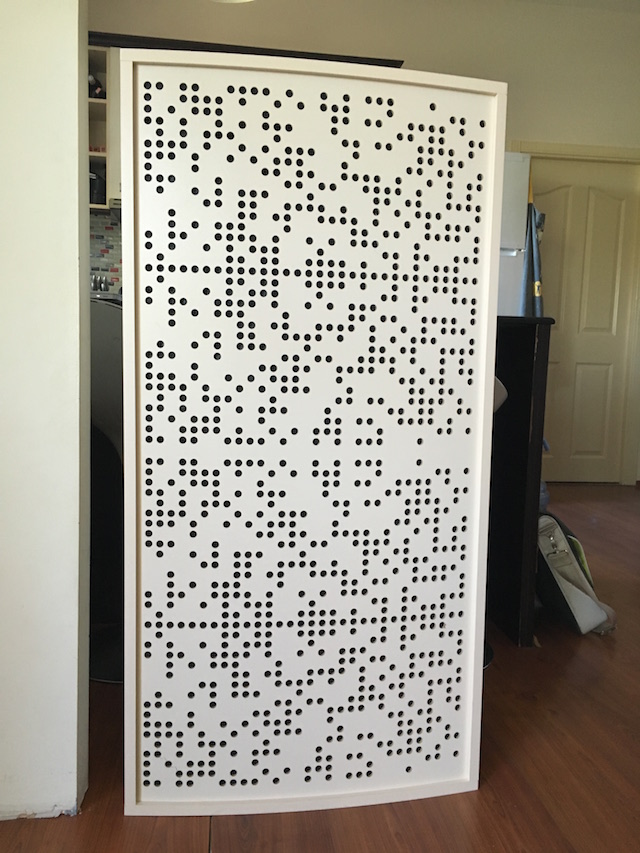
You can easily find the ideal amount of absorption you need in your space to get the right amount of reverberation. This will result in units of sabin. Only after choosing the right treatments, then you can start treating the first and second reflection points. Do not forget the ceiling. I also suggest appropiate quadratic diffusors if you are far enough from the walls and ceiling to be placed around your seating position.
|
|
|
|
Posted by anthony on
01-22-2016
|
|
fiogf49gjkf0d  Romy the Cat wrote: Romy the Cat wrote: |
Well, acg, I am not wild about your idea of the curved frame,
primary on the reason of esthetics but it is your speaker not mine and you
shall do whatever pleases you. A few mandatory things that I would like to
mention and I think you need to factor it into your design.
1) The Macondo channels shall form a curve or
parabola with your listening position being in center of a curve. I have illustrated
it years back at the following image: http://www.goodsoundclub.com/Site_Images/MacondoFrame31.jpg
I would very much discourage you to angle the horns and many foolish people do,
juts align the channels. To do so you would need to have a provision to move
the channels closer and further. Your current design does not allow you to do it.
You might avoid to move the channels closer and further if you calculate and
factor in the curvature and listening distance into the initials destine of the
channel arms.
|
|
Romy, here is a side elevation of sorts of the curved frame. In orange is the equal distance curve for a 3m listening distance measured from the upperbass driver as shown) with ears at the same level as the centre of the midrange horn (1.2m - about 4ft). The blue curve is for a 5m listening distance with the ears set at the same level as the centre of the midrange horn. The seating height is about right, it may end up a touch lower but I would be very surprised if is ends up any higher. The effect of a higher listening position is to push back all the higher channels above the upperbass, which this frame will not accommodate. The effect of a lower listening position is to draw forward all those channels, which this frame will accommodate.
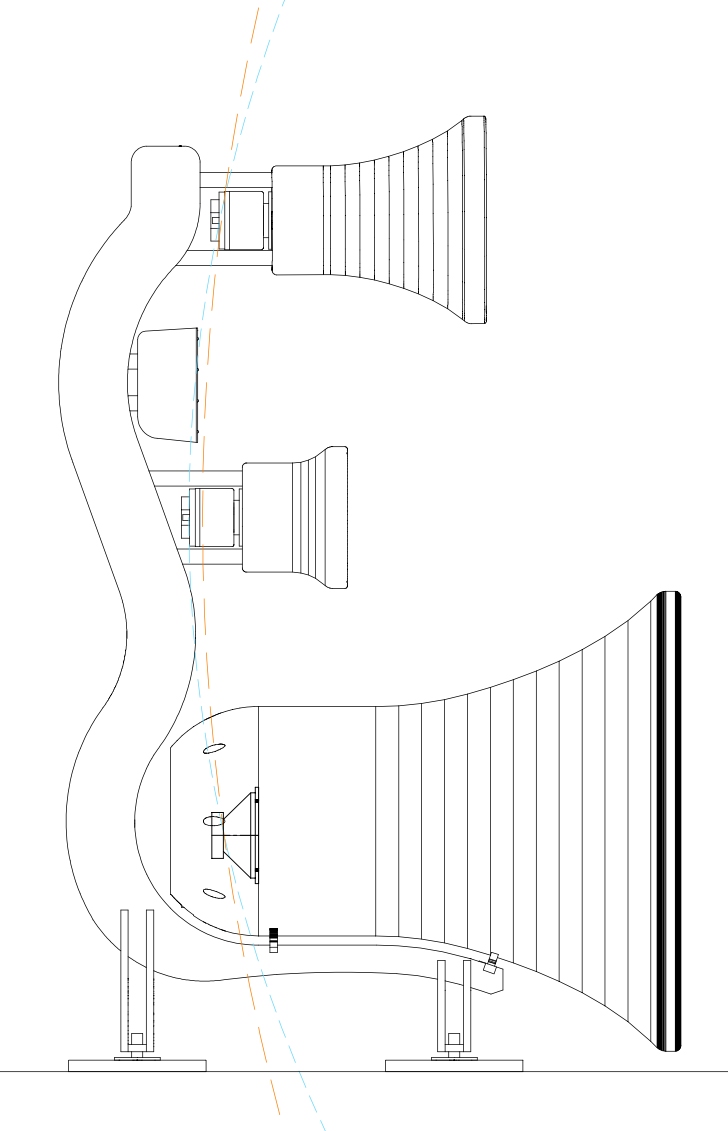
Each of those three upper channels does have the ability to be moved forwards and backwards by adjusting two screws (one for each connecting 'rod' of each channel) and they have about 80mm-100mm (3" - 4") of horizontal movement available. Each turn of the screws will move the channel by 1.5mm which should be accurate enough. If I run out of adjustment I can do one of two things: add longer rods to that channel; move the upperbass horn forwards.
 Romy the Cat wrote: Romy the Cat wrote: |
2) During the alignment of the channels you do not need to drop a plumb bob from the horn throat or the driver exit but from the location of the driver diaphragm. The S2 have diaphragm on the back, so you overshooting in your design good 5-6 inches
|
|
Sorry Romy, but that image was just a demonstration of one way for you to measure the offset, and so long as you were able to identify where you measured from and to then I would be able to replicate it here and get the right result. I did not mean it as a literal "measure from here to here".
 Romy the Cat wrote: Romy the Cat wrote: |
3) The time integration of MF and Upperbass is tricky. You can calculate where the Fane diaphragm is, where the S2 diaphragm is and they pretty much not on a curve but on direct vertical line. The precession of that calculation is kind of not important as Fane is not flat and has dome depth of the diaphragm. So, doing subjective assessments of the integration benefits I realized that all that you need to do between those channels is putting the MF atop of the point of max amplitude of upperbass. 500Hz has a wavelength of around 2.2 feet, 1000Hz is around 1.1feet. With such a long wave you will have a very high precision alignment if you align them approximately by geometry and then lock acoustically by summation of amplitude measurement. I did exactly this and then, after I knew the final position of my MF driver I order a fixed, well calculated arm for my tweeter. In my case I make my MF drive to position atop of positioning table with .01mm accuracy. I personally do not feel it is the best idea and I would rather advise to make HF being able to be .01mm positioned by MF would be fine with 1-2mm. You would not need a machinist position table for it and some kind of general slider would be fine.
|
|
Thanks for this information Romy. Are you able to tell me the horizontal and vertical separation that you are using between the ubberbass and midrange channels? I would still like to be a little more sure before I get steel cut for the frames. I have the midrange horns built but the upperbass horns will not be ready for a while so I cannot measure it myself at this stage, and I would like to have the frames built, painted and ready to accept the upperbass horns as soon as I finish turning them.
 Romy the Cat wrote: Romy the Cat wrote: |
4) You do want to lock the location of the Midbass horn with the frame and it will be moving side to side. A horn that angles breaks time alignment.
|
|
Do you mean locking the upperbass horn to the frame? If so , then yes, that is my plan, mainly because it is so heavy and I would not look forward to moving it.
 Romy the Cat wrote: Romy the Cat wrote: |
PS: I won’t be reading too much at the Australian site not to mention that I can’t see the pictures. So, if you need anything then ask here. |
|
Will do, thankyou.
|
|
|
|
Posted by anthony on
01-22-2016
|
|
fiogf49gjkf0d  kodomo wrote: kodomo wrote: | Great project! I have a similar project going on. Your frame ideas are looking beautiful, however I decided to take a more utilitarian road. I can adjust all my channels in horizontal or vertical axis. I am finishing my crossovers as of these days, and they are 6db except for the bass towers which are 12db. I had to do impedance equalisation to be able to use the 6db filters to work. Months and months of listening and measuring for me and even after everything is finished. The channel attenuation according to my space will continue for a few months more until I am fully satisfied... You can see my project here: http://tempuri.org/tempuri.html
May I suggest using impulse response when aligning the relative drivers. This is the most accurate way of doing it as far as I know.
You need a sound card with at least two inputs, and a microphone. REW is free and is able to help you with this. If you need further information on how to do it, I would try and explain it in more detail to you.
I would also look at acoustics of your space. I am an interior architect and studied acoustics. I have also worked in music studios and am a musician who owns a private music studio as well. Please do not skip on spatial acoustics, they have as much effect as any part of your signal chain. I have made some acoustic panels according to my needs too. They are multi-purpose and effective panels. The outer shell is 1d diffusor that works up to 4500hz. I have special fabric behind it and then 10cm of 100kg/m3 mineral fibre, which is quite effective (about 1 sabin from 150hz and upwards) down to lower cutoff of my upperbass 110hz horn. If you can put spacers in between the wall and the panel you can bring it further down to about 80-100hz effectively. Believe me, if people tell you they can effect 20-40hz with their panels, it is either to a very low effect, or an incredibly thick panel that is alos strategically placed or they don't know what they are talking about. Some panels with resonators in perfect spots may have an effect lower than 80hz, if there are enough of them in your space. Anyway, here are the panels I built. They are known as BAD panels commercially. I need 12 of these panels, plus 4 thicker panels in my space. I also needed about 12 of 60x60cm quadratic 3d diffusors. Oh and yes I am a bachelor 

You can easily find the ideal amount of absorption you need in your space to get the right amount of reverberation. This will result in units of sabin. Only after choosing the right treatments, then you can start treating the first and second reflection points. Do not forget the ceiling. I also suggest appropiate quadratic diffusors if you are far enough from the walls and ceiling to be placed around your seating position. |
|
Thanks for the input kodomo. I do like the look of your horns as well, but I don't envy not having a strong starting point for my drivers and horns, so kudos to you for going that route.
Regarding room treatment, I am renovating a room at the moment and making an effort to soundproof it a little. I wish it was larger, but I have to work with what I have got and I am quite sure I can get it to work in the end. Luckily it is 'my' space to do with almost as I please, although it will be used by the entire family once everything it setup. A very important part of that room will be the acoustic treatment and with the soundproofing I am expecting the job of getting the speakers to play the room properly to be more challenging than normal. I may call upon you for your input when that time comes around.
Cheers,
Anthony
|
|
|
|
Posted by anthony on
04-05-2017
|
...I think it has something to do with a small obsessive part of my personality, but as I have spent more and more time on this project I have wanted to do a better job as far as quality of workmanship and design and aesthetics are concerned. After all, if I get it right I could be sitting in front of this system for the remainder of my days.
Over the past few months I have spent a lot of time in CAD to get a good layout in the DSET amplifer and a unique visual presentation of the entire system that is a little bit industrial, a little bit retro and a little bit timeless. I am happy where the design is at right now and will shortly order the steel to be cut and will start putting together something that makes some sound.
Here is the current concept:
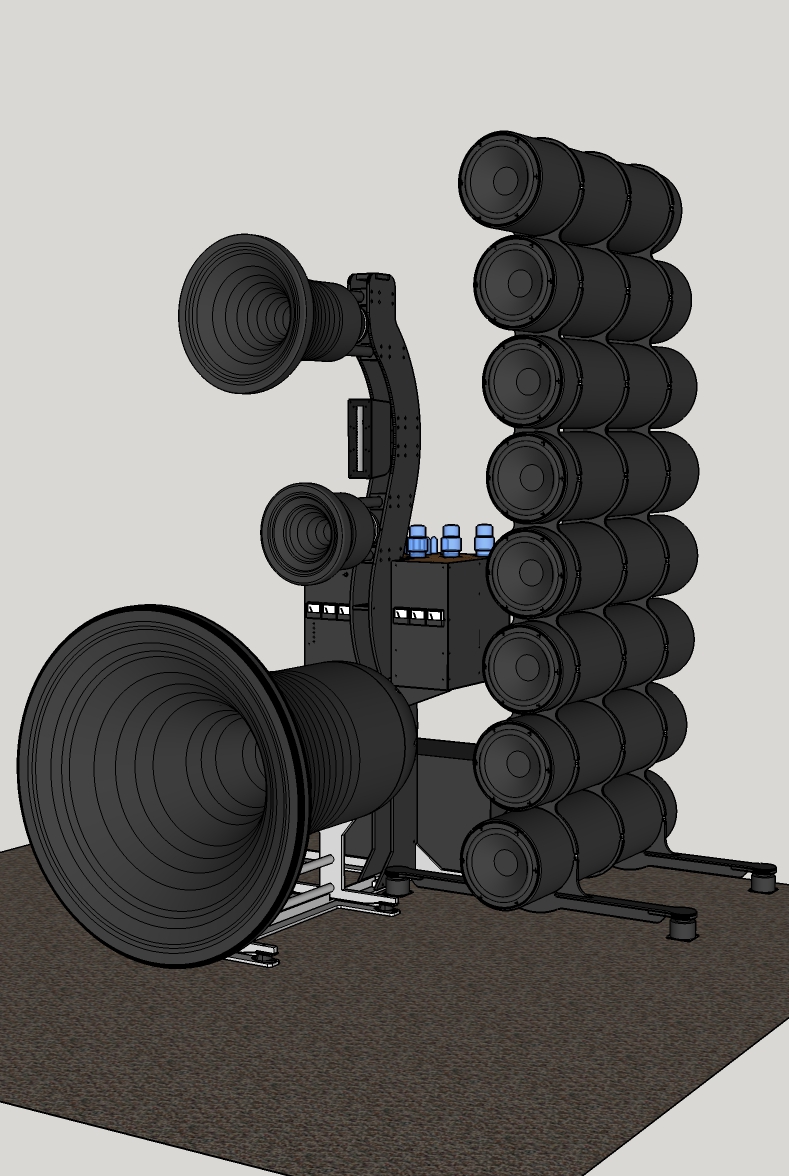
Notice the amplifier is attached to the horn stack and the woofer array is very modular. Here is the view from the listening chair:
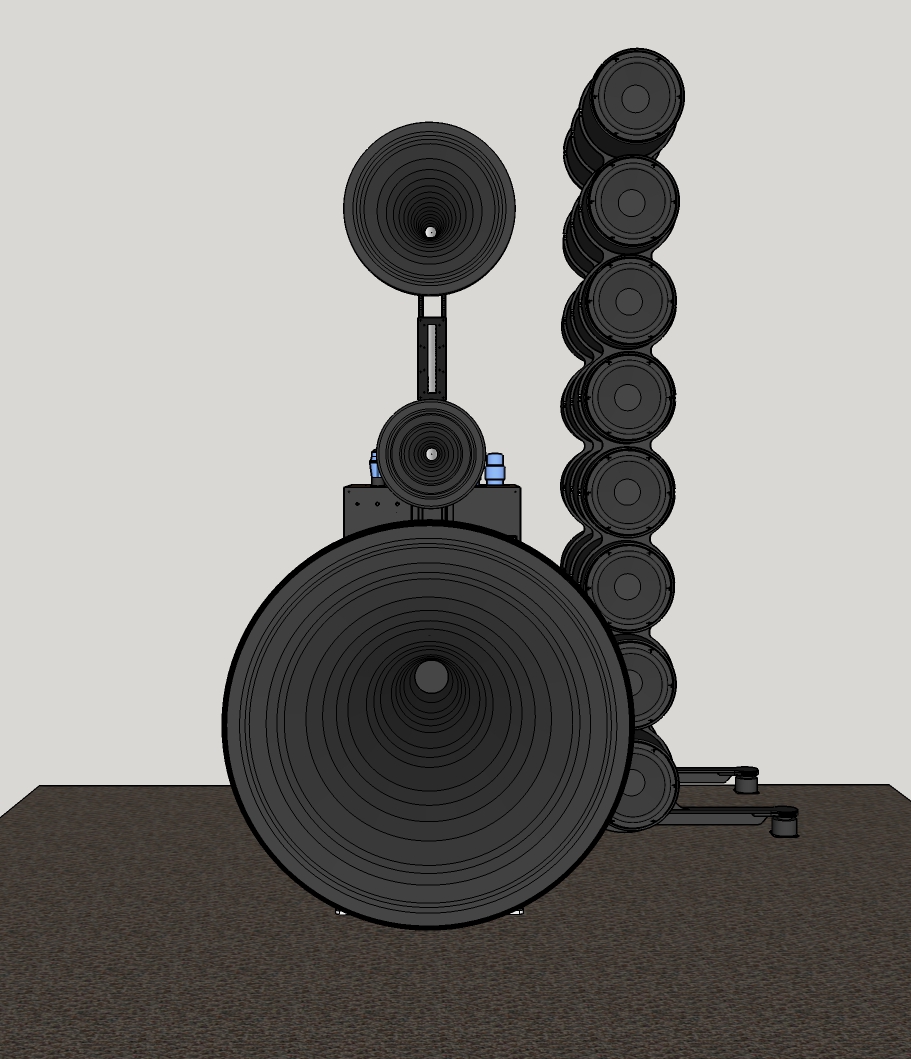
The tubes are largely out of sight, which is good and the given the enormity of the objects it all cuts quite a slim silhouette. Below is more detail on the woofer array that I have nicknamed the Bass Cannons for obvious reasons:
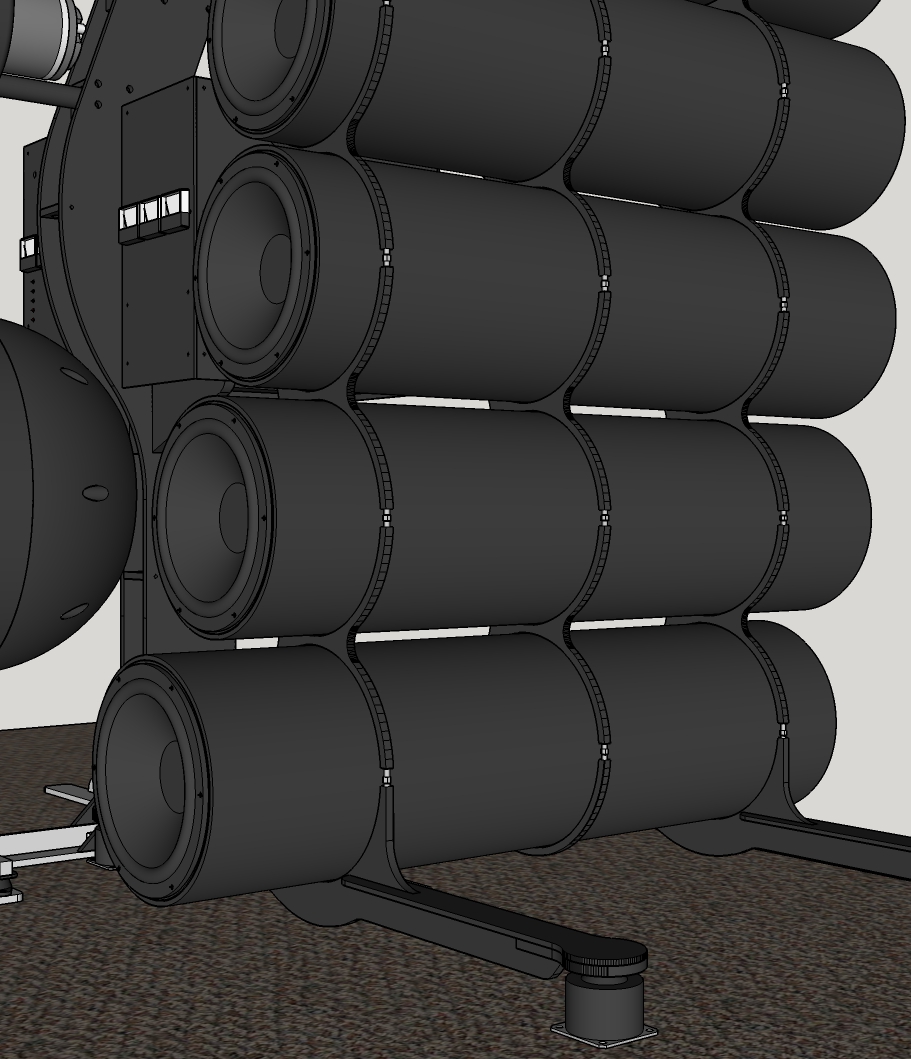
They are a modular design. If I want a stack of 4 then I just put four up, likewise if I want 8 then I put up 8. Each Cannon can be shifted forward and backward to suit my whim, but I do like the look of them curved to be equidistant from the listeners head. The Cannons are 1m (40") long and 4.8mm thick steel. Front and back plates will be welded on and the 25W/8565-00 drivers just screwed onto the front plate. The external bracing not only applies pressure to the pipe wall which pre-stresses it and increases rigidity, but they are also the means by which the Cannons above can be attached. Quite a simple concept.
I have the first steel here to make up a couple of Cannons and test to make sure that I can get them to work appropriately. Fingers crossed that they work out otherwise it is back to the drawing board.

As you can see from the side I have tried to make the main pillar for the horn stack to look as though it has sprouted and grown from the floor. It will be powdercoated matte black but the portion of the frame on the floor will be powdercoated to match as closely as possible the colour of the carpet. The DSET sits up on the horn pillar and its power supply down on the floor below. Three short cables will interconnect those boxes. On the very top of the horn pillar is a platform to which I can add another channel if required. I may need to put in another bass channel so that may prove a good spot, or I can experiment with an Injection Channel.
From the rear:
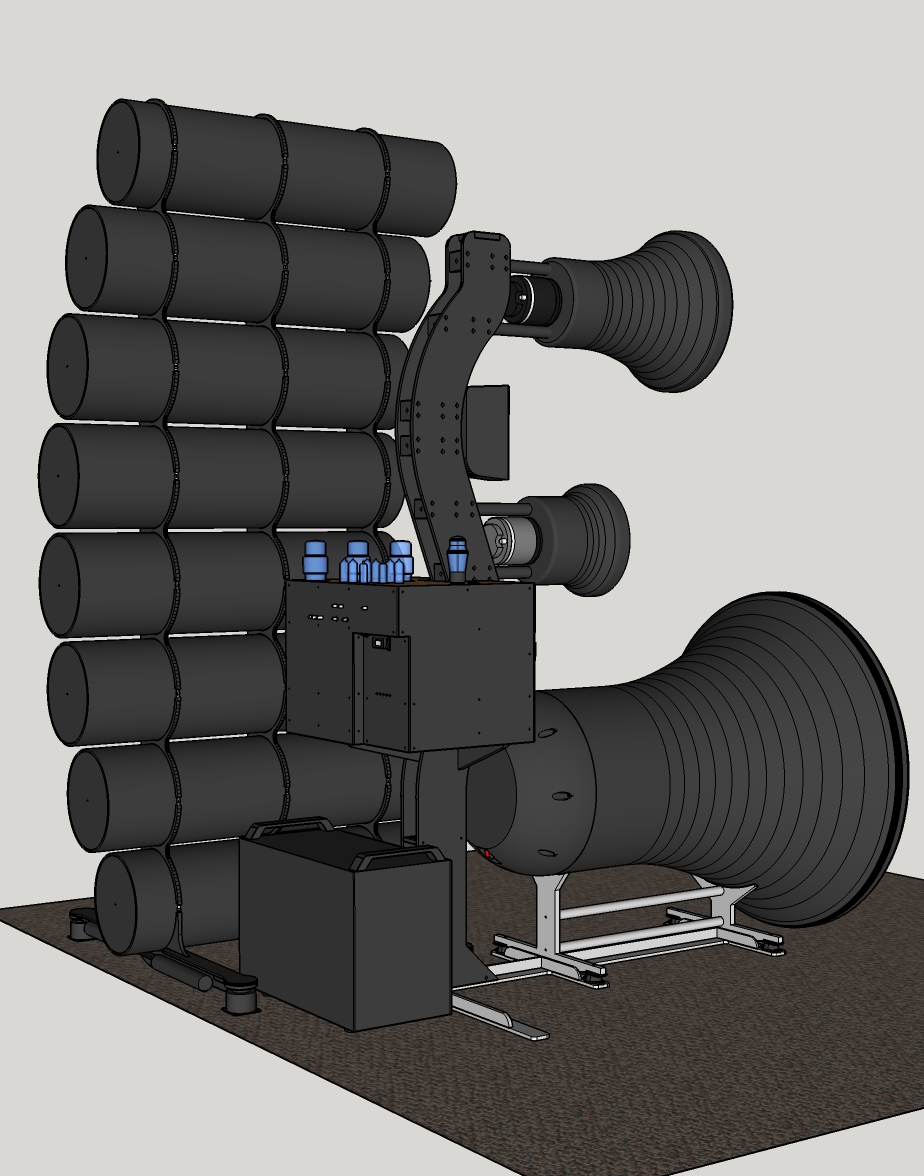
Below you can see how the DSET wraps around the horn pillar. This is very intentional. The speaker cables will exit the amplifier case in that recess behind the horn pillar and makes their various transits to their respective drivers within the horn pillar...no visible speaker cables! The idea of being able to hide the speaker cables is one of the big attractions of having the DSET mounted to the horn stack. Plus I intend to solder the speaker cables directly to the output transformers.
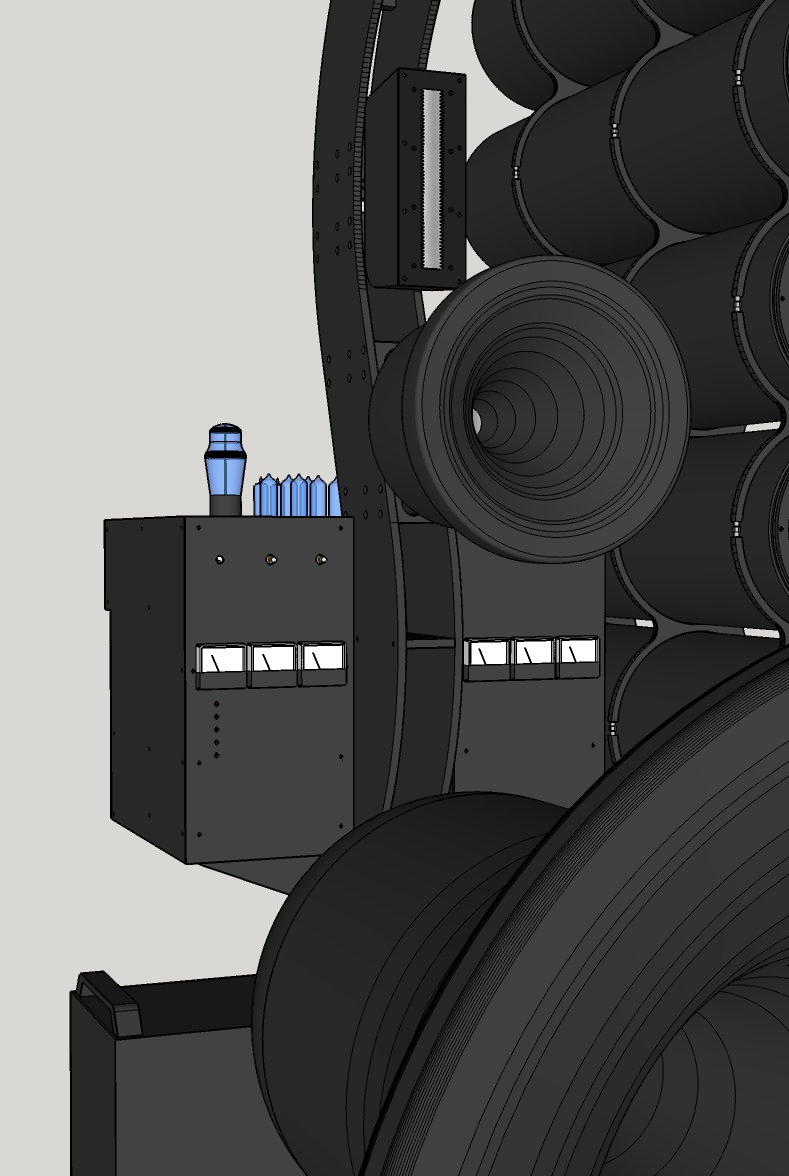
Notice the theatrical LED 'tears' that indicate the current power status of the various amplifier sections.
Shortly I will make post more information about the amplifier in that thread.
|
|
|
|
Posted by Romy the Cat on
04-05-2017
|
Here I share some thoughts about what you have shown. I will
share only critical and warning thoughts not because I have nothing but critiques.
All nessesary compliments for your planning come as a default and I do not
think you posted it here to hear salutations but you rather prefer to hear warning
from the people who have done it. Jessie, if you are around there then you
would be a good person to comment about your experience regarding this project
as you have done something similar. Anyhow here are some of my comments in no particular
order.
1)
I do not know why, and I never thought about it
unit I have done my project but I am very sensitive to visual aspect of what is
located juts behind the Macondo frame. As I look at the Macondo horns fixture
with the tweeter projects to the main frame it look sand feels very elegant and
symmetrical. For some reasons I do not like to see behind the frame anything that
screw up the elegance and symmetry. This is why I do not like to put Milqs amplifiers
behind the Macondo frame. I did try is multiple times and it did not feel good
to me. I personally much prefer when the amps not behind the frame but slightly
on the side of the frame. It just makes to me the whole playback configuration
more balanced. Do not forget that with Macondo configuration you will have the speaker’s
stage at ~14-16 feet minimal. With upper-bass horns of 36” you will have a LOT
of empty space between the speakers… Saying it I need to admit that it is just
me and your mileage might wary, it is not to mention that your amps is located
very low and you might not even see it,
2)
I do not buy the idea of tube woofers, I never
did it with the guy from Mexico and I still do not like it. First of all the harnesses
that you depicted will not work. This will be very heavy and you will need some
kind of heavy duty vertical poll to hold the whole stack together. The ability
to slide the individual woofers is a great thing but why not to do it in
rectangular boxes? If you are planning to use the woofers that I used then you
would need at least 1” foam in there – you will not have space in those small
10” tubes. If I did it and to have the objective to time-slide the woofers I
would make 4 rectangular sections with 2 drivers each and would make the front
baffle let say 5 degree angle. They I would be able to fulfill any configuration
by sliding and rotating an individual section. Well, I do think that to have 4
dual driver section with straight baffles will be fine as well…
3)
A missing channel. If you have your playback in
a small room and you will be lucky to have your upper bass horns at very active
spot of your room then you will be fine with the configuration you shown. I had
it what I live in Boston and my upper bass horns work very comfortable at 95 Hz
and they were in active room zones. If your room is larger and if the upper
bass horns are not at hot spot then you will have 130Hz of it this upper bass horns.
If you use my woofer then your cross them over 100Hz will be a bit problematic.
My woofers are very interesting. If you use it at 100Hz then they are more at
crap side. You need to cross them much lower. Then you begin to multiply them.
As you pile 4, 5 or 8 of them you have a substantially more interesting results.
8 of them you will be able to use even at 100Hz but only in small room and only
with very lightly loaded amplification. The woofers have own signature but very
pleasurable and much dominated by second harmonics. I tend to love. I can hear instantly
that my woofers are in playback and I agree that they are “coloration” but this
“coloration” agrees with me. So, you might consider to have a dedicated midbass
channels but to do it you your to take your room and your spear placement into
configuration. You do not know it yet and then you do not k now the crossovers,
gain and the OPT from app you might need. So do not rush as at this point not everything
might be predicated. What I would adviser is to buy 2 of my woofer and play car
audio game with them, trust me, it is very educational.
|
|
|
|
Posted by anthony on
04-05-2017
|
 Romy the Cat wrote: Romy the Cat wrote: | Here I share some thoughts about what you have shown. I will
share only critical and warning thoughts not because I have nothing but critiques.
All nessesary compliments for your planning come as a default and I do not
think you posted it here to hear salutations but you rather prefer to hear warning
from the people who have done it. Jessie, if you are around there then you
would be a good person to comment about your experience regarding this project
as you have done something similar. Anyhow here are some of my comments in no particular
order.
1)
I do not know why, and I never thought about it
unit I have done my project but I am very sensitive to visual aspect of what is
located juts behind the Macondo frame. As I look at the Macondo horns fixture
with the tweeter projects to the main frame it look sand feels very elegant and
symmetrical. For some reasons I do not like to see behind the frame anything that
screw up the elegance and symmetry. This is why I do not like to put Milqs amplifiers
behind the Macondo frame. I did try is multiple times and it did not feel good
to me. I personally much prefer when the amps not behind the frame but slightly
on the side of the frame. It just makes to me the whole playback configuration
more balanced. Do not forget that with Macondo configuration you will have the speaker’s
stage at ~14-16 feet minimal. With upper-bass horns of 36” you will have a LOT
of empty space between the speakers… Saying it I need to admit that it is just
me and your mileage might wary, it is not to mention that your amps is located
very low and you might not even see it,
|
|
Yes, the warnings of potential problems and suggestions for improvement are really what I would like to hear.
It is interesting that you have mentioned the symmetry thing in regards to what is behind the horn stack. I have oscillated in what I wanted in regard to where the amplifers sit and how much of them I want to see or don't want to see. When initially thinking about building the DSET I thought that it would be nice to see the glow of the tubes in all of their glory and to really show them off, but over time that idea has mellowed. It mellowed especially once I had the fullrange Melq prototype in the listening room and found myself distracted by its glow when sitting in the dark and then thought of what two dozen glowing tubes would do compared to the four that I had in the room at that time. So now I don't want to see all of the tubes while listening and think I could be quite happy if I did not see any of them from the listening chair...perhaps seeing a few and glimpsing some others is kind of like a tease...something held back...and is a worthy compromise.
In the end I am constrained by more practical concerns regarding the layout of components in the amplifier. The OPT's need to be at the front surrounding the recess that accepts the main pillar of the horn stack and I would prefer the interconnect to come in at the back so in the end I chose to "turn around" the tubes so that they are set opposite to your configuration i.e 6C33C closest to the listener and the gas regulators furthest away. I like this layout and it helps with the 'tease' where the tubes are a little on show but you have to make an effort to find them all. Another physical constraint is the height of the first bends in the main pillar of the horn stack. The speaker cables exit the case in the recess and that recess needs to be aligned for maximum room in relation to the horn pillar which in turn sets the height at which the amplifier sits. I do not have much wriggle room here so I can make the amplifier sit higher but realistically it can be no lower in an effort to hide the tubes altogether even if I really wanted to do that.
I do not mind a speaker system dominating the aesthetics of the room as these will do, but what I can't abide are components and cables and crap spread from Arthur to Martha on the floor and the room starting to resemble a hoarders lair. If it is big, it has to be tidy and contained and a significant part of that for me is getting the amplifiers on the horn stack and immediately eliminating most of that 'mess' of cables. From that train of thought the idea of separating the amplifier from the horn stack cannot be entertained.
One thing that I have not mentioned is that the amplifiers will be mirror pairs so what is on the inside of the left mono is also on the inside of the right mono. For my own sensibilities this was essential.
 Romy the Cat wrote: Romy the Cat wrote: |
2) I do not buy the idea of tube woofers, I never did it with the guy from Mexico and I still do not like it. First of all the harnesses that you depicted will not work. This will be very heavy and you will need some kind of heavy duty vertical poll to hold the whole stack together. The ability to slide the individual woofers is a great thing but why not to do it in rectangular boxes? If you are planning to use the woofers that I used then you would need at least 1” foam in there – you will not have space in those small 10” tubes. If I did it and to have the objective to time-slide the woofers I would make 4 rectangular sections with 2 drivers each and would make the front baffle let say 5 degree angle. They I would be able to fulfill any configuration by sliding and rotating an individual section. Well, I do think that to have 4 dual driver section with straight baffles will be fine as well…
|
|
I will build some wood boxes to test against the steel cannons, but there are two main reasons why I a prefer the steel tubes at this stage:- There is less work for me in the steel construction. This Macondo/Melquiades build has been going over two years now and I really want some results. With the wood box I would be compelled to build them and finish them and paint them which is a lot of time that I can put elsewhere. With the steel construction I have them laser cut, a guy I know will weld them for me (my welding is amateur at best) and I will have them powdercoated by someone else and the colour match will be perfect with the power supply and amplifier cases. All I have to do is drill and tap some holes in steel which I can do over the course of a weekend.
- I have designed the 2 driver wood boxes and when I stack them and put them next to my horn stack in CAD they are just not as pretty as the steel tubes and actually detract from the aesthetics in my opinion. The main problem is the width of the front baffle and the long straight sides that seem to not compliment the horns. They are different to your woofer towers Romy in that the drivers have no vertical separation between them and I am limited to a 1m (40") depth so the baffle needs to be wider than yours. My wood version looks more bloated and oversized by comparison.
 Romy the Cat wrote: Romy the Cat wrote: |
3) A missing channel. If you have your playback in a small room and you will be lucky to have your upper bass horns at very active spot of your room then you will be fine with the configuration you shown. I had it what I live in Boston and my upper bass horns work very comfortable at 95 Hz and they were in active room zones. If your room is larger and if the upper bass horns are not at hot spot then you will have 130Hz of it this upper bass horns. If you use my woofer then your cross them over 100Hz will be a bit problematic. My woofers are very interesting. If you use it at 100Hz then they are more at crap side. You need to cross them much lower. Then you begin to multiply them. As you pile 4, 5 or 8 of them you have a substantially more interesting results. 8 of them you will be able to use even at 100Hz but only in small room and only with very lightly loaded amplification. The woofers have own signature but very pleasurable and much dominated by second harmonics. I tend to love. I can hear instantly that my woofers are in playback and I agree that they are “coloration” but this “coloration” agrees with me. So, you might consider to have a dedicated midbass channels but to do it you your to take your room and your spear placement into configuration. You do not know it yet and then you do not k now the crossovers, gain and the OPT from app you might need. So do not rush as at this point not everything might be predicated. What I would adviser is to buy 2 of my woofer and play car audio game with them, trust me, it is very educational. |
|
This is excellent information Romy. I have been worried about crossing the woofers at 100Hz and would be much happier if I was able to cross them lower. We will see how everything integrates into the room and if I do need the extra channel for mid-bass. I have allowed for it in the design so far, but just have not actually designed such a channel.
|
|
|
|
Posted by anthony on
04-05-2017
|
 anthony wrote: anthony wrote: |
- I have designed the 2 driver wood boxes and when I stack them and put them next to my horn stack in CAD they are just not as pretty as the steel tubes and actually detract from the aesthetics in my opinion. The main problem is the width of the front baffle and the long straight sides that seem to not compliment the horns. They are different to your woofer towers Romy in that the drivers have no vertical separation between them and I am limited to a 1m (40") depth so the baffle needs to be wider than yours. My wood version looks more bloated and oversized by comparison.
|
|
To further this discussion I thought I would add some images of the two woofer tower possibilities taken from exactly the same vantage points.
First, from the listening chair:
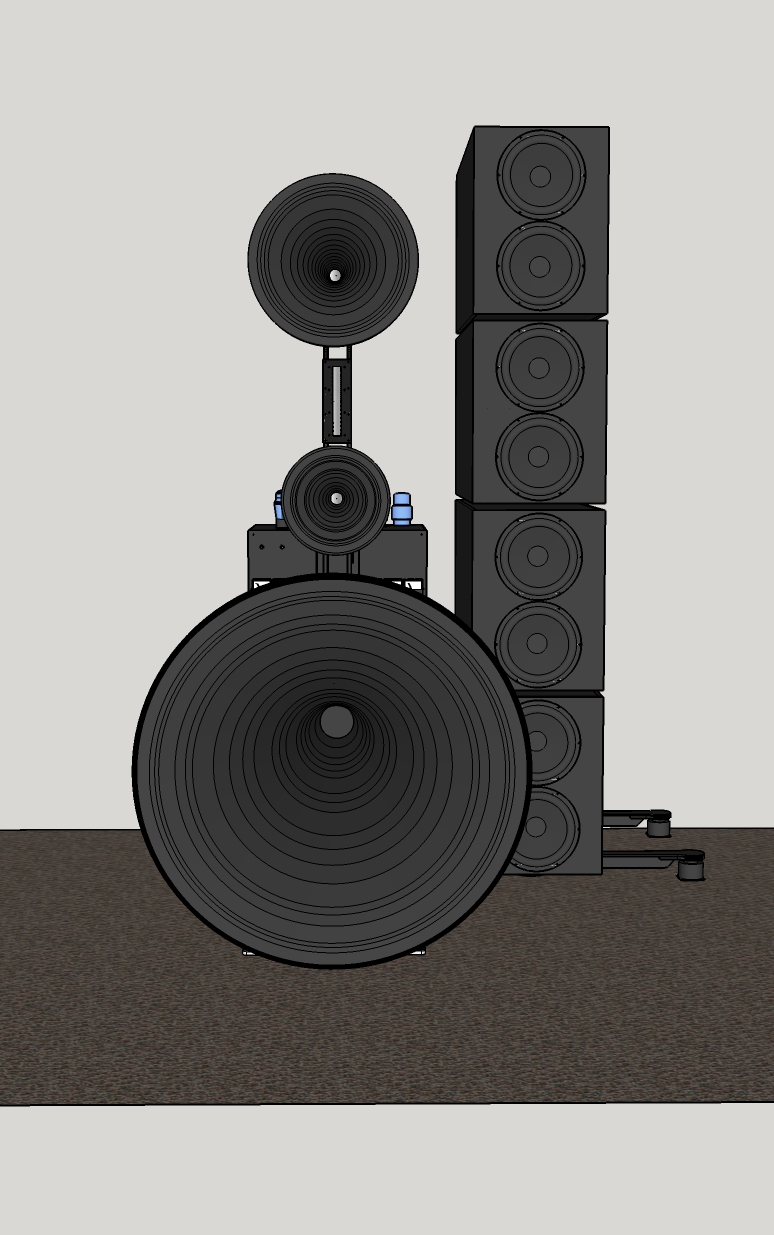 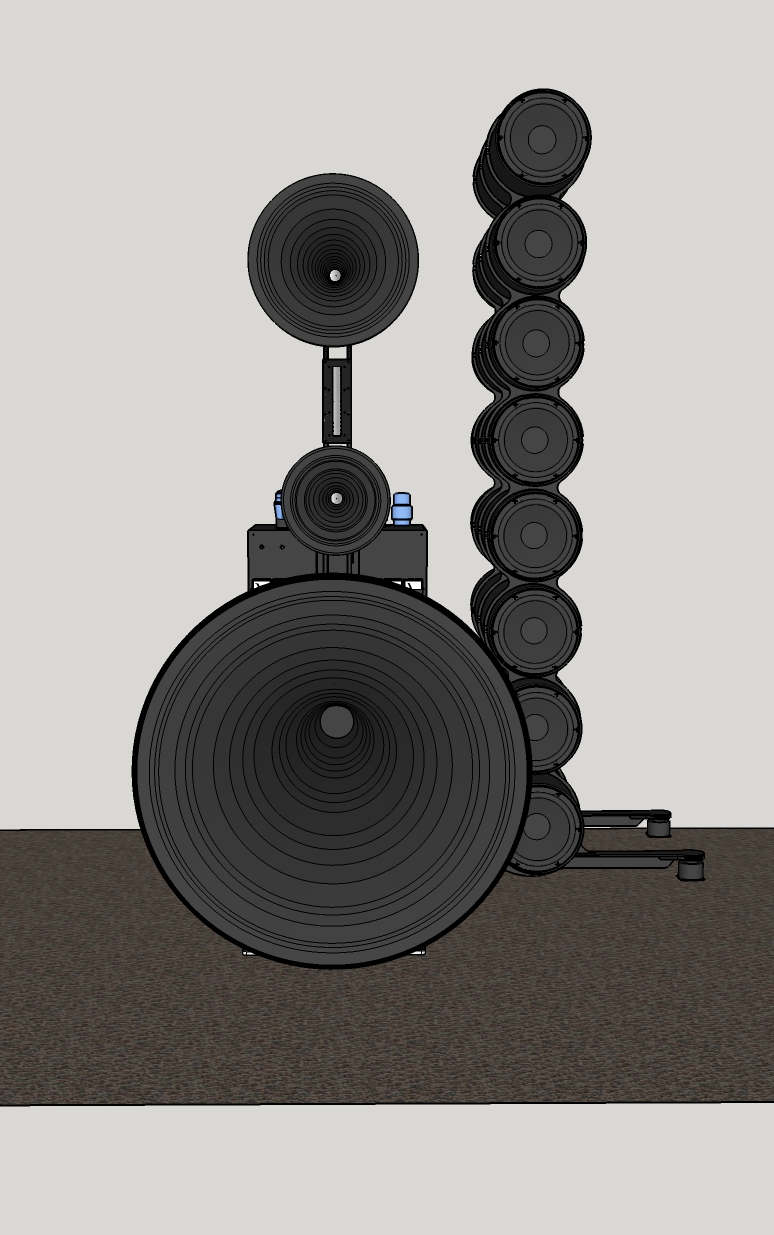
From the 'inside':
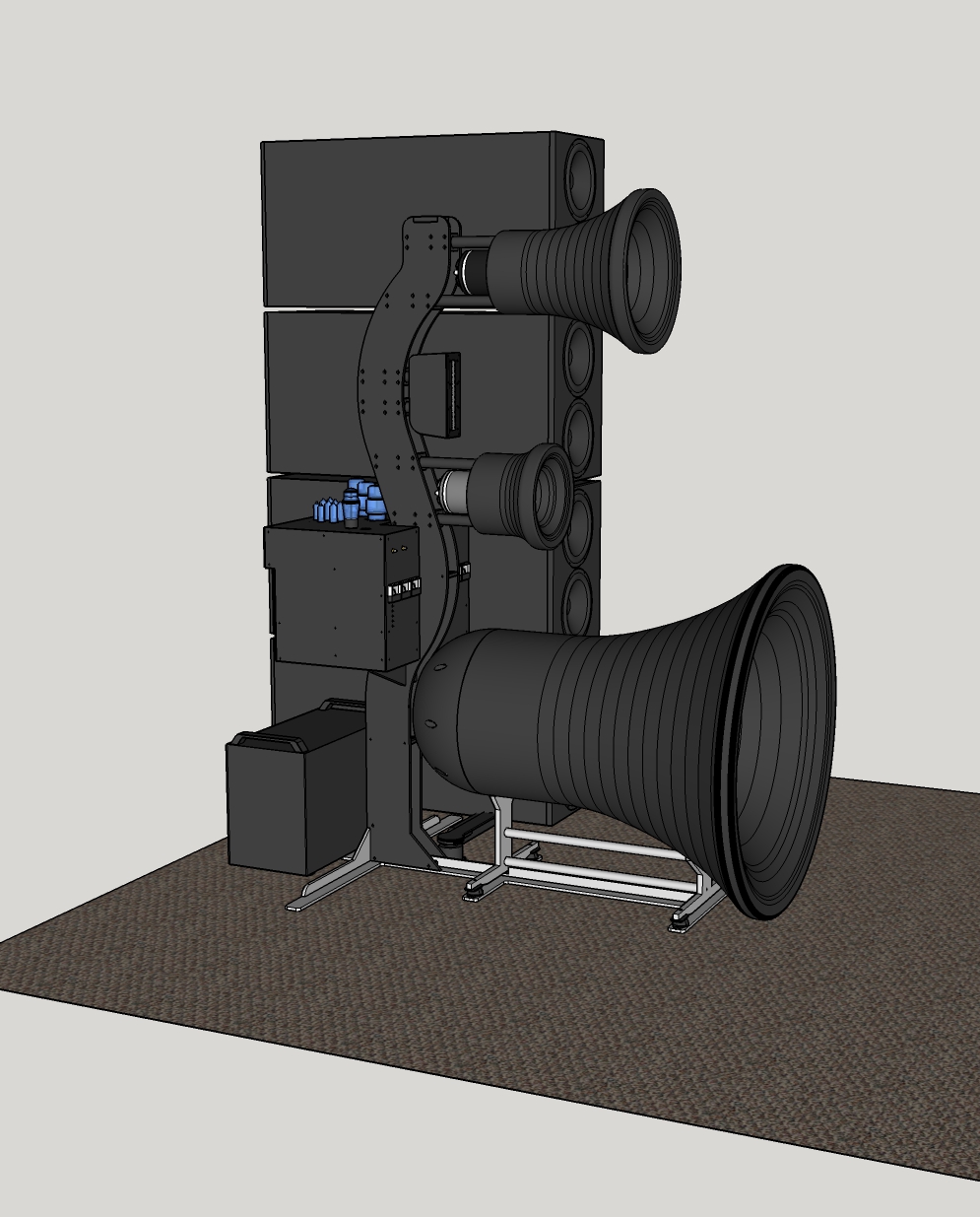
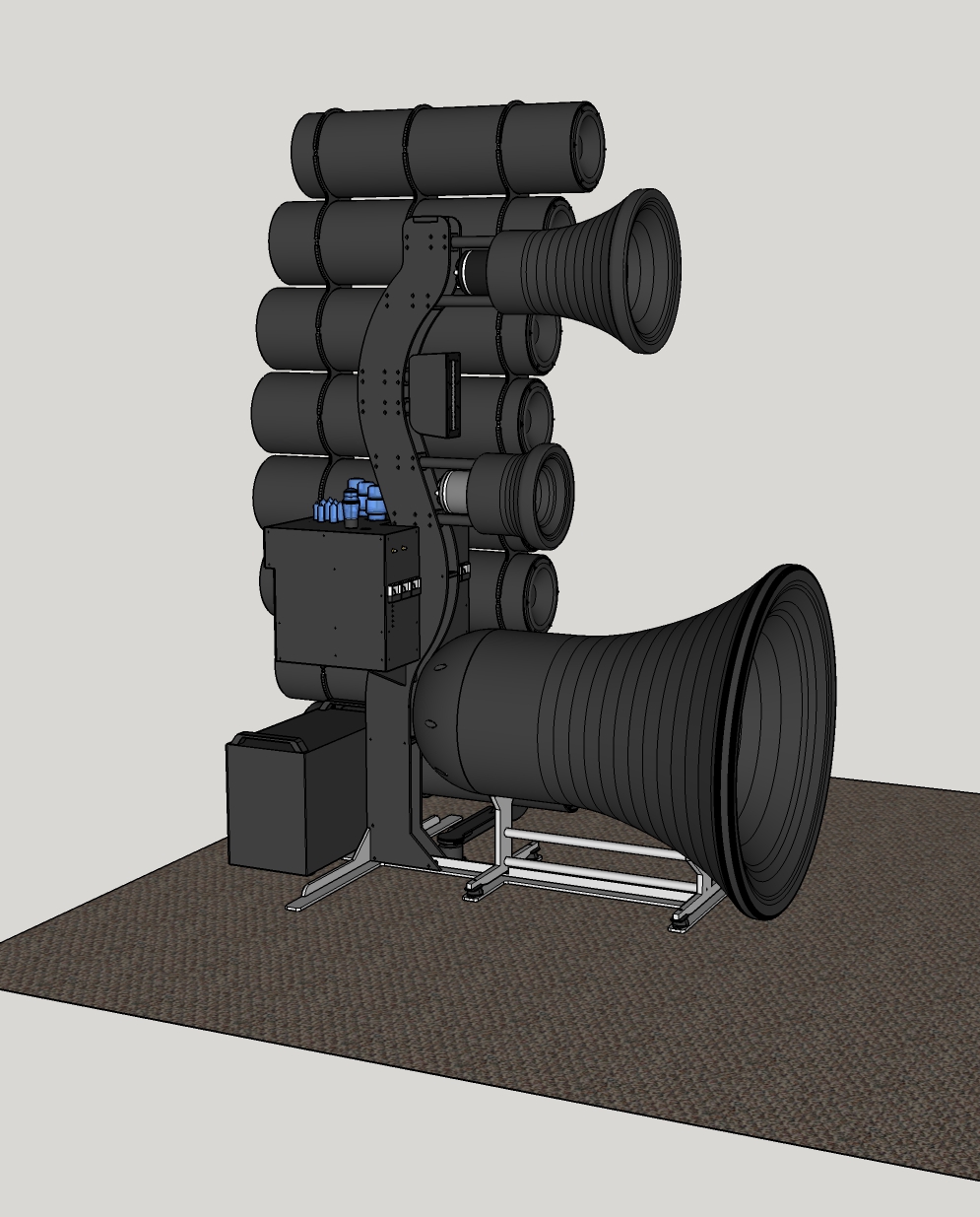
From the 'outside':

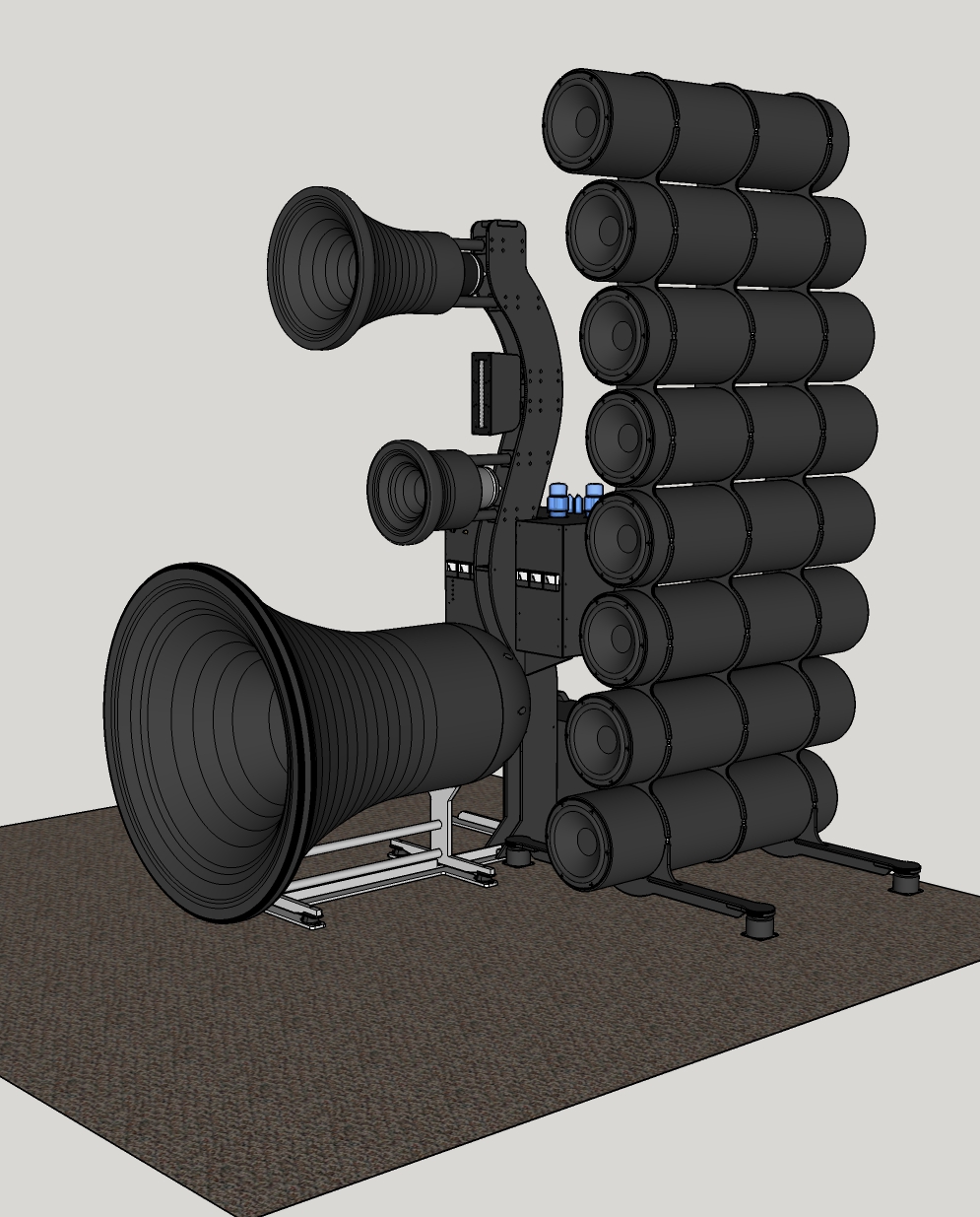
|
|
|
|
Posted by oxric on
04-05-2017
|
| oxric wrote: |
Hi Anthony,
I am amazed by the work you have accomplished so far and love your stands and horns stacks.
Two comments though in term of overall esthetics although I realise that having spent so much time on this it may be too late to make changes.
I would not have the amplifier hidden behind the main pillar supporting the horns. It distracts from the beautiful lines of horns and support. In addition, I think, if only in theory, to completely isolate your amplifiers and power supplies from your horns and drivers, would be a good thing. I appreciate that you do reduce cable lengths by doing so but am inclined to think that by positioning your amplifiers along side walls, the benefits outweigh these other disadvantages.
Secondly, the bass cannons. Sadurni Acoustics does something very similar but I think this contraption with the several separate individual bass enclosures is an unecessary distraction from the horns and support. I would try to use a bass tower, maybe two modules of 4 drivers each, and still make provision for alignment of these drivers within its design.
Please ignore comments at leisure as your project is quite remarkable as it is.
rgds
Rakesh |
|
Hi Rakesh,
I've talked about this stuff in the other thread on this site so maybe pop over there and leave your opinion on the bass array. Thanks for you compliments by the way.
Regards,
Anthony
Hi Anthony,
In addition to the above and in light of your helpful rendering above...
I see you have thought deeply about the location of your amps and I can see how functionally they fit perfectly where you have located them. They will make moving your horns more challenging though, in the initial setting up period, although this becomes an irrelevant consideration once you have found the right location.
Regarding the bass cannons compared to the rectangular bass enclosures. I can see how the rectangular solutions might look 'out of place.' However, it is also important to note that too many curves might be too much of a good thing and uniform cylindrical structures are not necessarily more in harmony with the bell shape structure of your horns. Your rectangular structures are very monolithic and nearly brutalist in terms of appearance but they most certainly do not have to be that way.
All the best
Rakesh
|
|
|
|
Posted by kodomo on
04-06-2017
|
Hey Anthony,
Your project is going on track (and looks like a very good track)!
Just a reminder about the room acoustics. You are talking about bass frequencies which are as dependent to the room as the speaker! Before installing your speakers into your room, calculate the nodes and the amount of absorption you need to cover the room from the dimensions of your room and use specific acoustic treatment for that. An appropriate rt60 and a balanced room response creates a very nice listening. Even though this is a horn system, you will be still listening to your room and not just the horns.
Treat the problematic bass regions first, this means all the corners you can cover. You can also build a front wall or a back wall diffuser or both from Tim Perry's plans. Remember the distance from the diffusers are very important for even response. So the depth you choose for your wells in your diffusers will dictate the frequency they will cover and the minimum distance they have to be from the listener. Then install your speakers, remeasure and then address your problems again, starting with the first reflection points. When you have the specific place for your speakers, the first and the second reflection points will be known. I suggest treating not only walls, but also the ceiling in the first and second reflection points. Remember this is not a recording room but a listening environment, so you are aiming to get closer to a non-environment room (not completely)
Here are the links for diffusers and absorbers, I suggest you to build
http://arqen.com/sound-diffusers/
http://arqen.com/bass-traps-101/placement-guide/
I can also share my diffuser/absorber panels plans but they are for my specific room, you can however use the idea.
|
|
|
|
Posted by Romy the Cat on
04-06-2017
|
 anthony wrote: anthony wrote: | | This is excellent
information Romy. I have been worried about crossing the woofers at 100Hz
and would be much happier if I was able to cross them lower. We will see
how everything integrates into the room and if I do need the extra channel for
mid-bass. I have allowed for it in the design so far, but just have not
actually designed such a channel. |
|
Well, it is kind of self-ajusting believe me or
not. You see in your amp the max gain you will need from you LF channel, so it
will be having the maximum gain compared to other channels that will be attenuated.
As you have your LF section (the tower of tubes) in place and connect it to
your LF section you will be able to see what gain your playback has in your specific
room. You will line up the rest of the channels and will have witness what the level
of loudness you will have and if it is enough for you. They you will see how
your LF is rolling off. The LF will collapse first but it will be all depends
of your room. My first room was about 400sq feet, my second, in the house with
bass horn was around 650sq feet and my current around 600 sq feet. My last two
room had open floor plan with a lot of potential for LF to escape, so I need to
put a LOT of power into LF bass to EQ the room. In my first room that did not
have open floor plan it had a very good result by crossing at 107Hz second
order of 73Hz first order. The uppercase was at the reference level with the
rest of the horn and the room gain did wonder with lower bass. I was able to accomplish
it all with one amp and one channel (Per side). That was the idea to use 6C33C
what with 15W and 6 driver per side was able to operate very comfortably in
class A1. I even had a room to play with idling of my LF amp and I think I made
it to run 4R or something like this…
How about the self-ajusting. In the consecutive rooms
the power and gain of my LF channels was not enough to drive my LF to cover the
whole 3 octave at the bottom. So, on my former room I used the LF channel to
drive my bass horns (attenuated) and in my current room I use the LF channel to
drive my midbass module with Vitavox 15 tandems. Naturally in my current and
former rooms the LF line array become ULF channels and require a different application
which is way more powerful then what Milq can offer. So, as you can see the
Milq LF channel is never wasted. In a small and sealed room it can act at LF channel
and in a big and open room it doe fine was upper bass channel.
|
|
|
|
Posted by Romy the Cat on
04-06-2017
|
 kodomo wrote: kodomo wrote: | | Just a reminder about the room acoustics. You are
talking about bass frequencies which are as dependent to the room as the
speaker! Before installing your speakers into your room, calculate the nodes
and the amount of absorption you need to cover the room from the dimensions of
your room and use specific acoustic treatment for that. An appropriate rt60 and
a balanced room response creates a very nice listening. Even though this is a
horn system, you will be still listening to your room and not just the horns. |
|
Kodomo, I do not say it is
unnecessary but I do not think it is possible for Anthony at this point.
The calculating of testing the nodes is questionable task and I would advise do
not do it. Anybody who undertake the project as Anthony does had some
kind of playback in the room before and knows the room basic problems and strengths.
To think now about absorption, diffusion and the rest of the game is completely
pointless. I think people shall address the problem in order the problems arrive.
As peoples has a basic Macondo rendered in the room he will play with it to imbedding
it in his specific room. At that time he will be changing the crossovers, move
the speakers, play with acoustic treatment. There is no k now to me was how a person
can model it. The whole idea to play with the speakers in your room is to teach
yourself about the speakers and the room. So, I do advise do not invest into
any acoustic treatment ... unless you feel/hear a need for the acoustic treatment.
|
|
|
|
Posted by anthony on
04-06-2017
|
 kodomo wrote: kodomo wrote: | Hey Anthony,
Your project is going on track (and looks like a very good track)!
Just a reminder about the room acoustics. You are talking about bass frequencies which are as dependent to the room as the speaker! Before installing your speakers into your room, calculate the nodes and the amount of absorption you need to cover the room from the dimensions of your room and use specific acoustic treatment for that. An appropriate rt60 and a balanced room response creates a very nice listening. Even though this is a horn system, you will be still listening to your room and not just the horns.
Treat the problematic bass regions first, this means all the corners you can cover. You can also build a front wall or a back wall diffuser or both from Tim Perry's plans. Remember the distance from the diffusers are very important for even response. So the depth you choose for your wells in your diffusers will dictate the frequency they will cover and the minimum distance they have to be from the listener. Then install your speakers, remeasure and then address your problems again, starting with the first reflection points. When you have the specific place for your speakers, the first and the second reflection points will be known. I suggest treating not only walls, but also the ceiling in the first and second reflection points. Remember this is not a recording room but a listening environment, so you are aiming to get closer to a non-environment room (not completely)
Here are the links for diffusers and absorbers, I suggest you to build
http://arqen.com/sound-diffusers/
http://arqen.com/bass-traps-101/placement-guide/
I can also share my diffuser/absorber panels plans but they are for my specific room, you can however use the idea.
|
|
Thank's for your offer Kodomo, I may take you up on it at some stage.
Last year I vetted some acoustic consultants and made a decision as to who I would get to help me with the acoustics of my new room. The guy I have selected is particularly straight talking and above all seems very practical and experienced. Some of the things that he said when I met him in person I have not read (or to be honest noticed) online or in books on the subject and he seems someone not prone to fads or crazy ideas so may provide a good foil for someone like me that does not have experience and is naturally attracted to something with great numbers on paper.
As is so happens I reconnected with him earlier this week and we are in the process of formulating a plan going forward that will suit my construction schedule and the level of diy that I wish to achieve. My room is new and it does have a rudimentary playback and sitting in it at this stage there are obvious problems with the sound. At this stage I would like to take steps to tidy up the sound that I currently have in the room such as bass and flutter echoes but not go overboard on the treatment until I am ready to embed my Macondo into the room.
I am not yet even sure where the speakers will go in the room - on the long wall or the short wall. I have an idea that is a little unconventional and I may need my acoustic consultant to talk some sense back into me...
 Romy the Cat wrote: Romy the Cat wrote: | Kodomo, I do not say it is unnecessary but I do not think it is possible for Anthony at this point. The calculating of testing the nodes is questionable task and I would advise do not do it. Anybody who undertake the project as Anthony does had some kind of playback in the room before and knows the room basic problems and strengths. To think now about absorption, diffusion and the rest of the game is completely pointless. I think people shall address the problem in order the problems arrive. As peoples has a basic Macondo rendered in the room he will play with it to imbedding it in his specific room. At that time he will be changing the crossovers, move the speakers, play with acoustic treatment. There is no k now to me was how a person can model it. The whole idea to play with the speakers in your room is to teach yourself about the speakers and the room. So, I do advise do not invest into any acoustic treatment ... unless you feel/hear a need for the acoustic treatment. |
|
Yes, this is the approach that I envisage will occur, although I would like to take some small steps now with temporary placement of devices to treat flutter echoes and maybe some broadband absorption in the bass frequencies. To be honest I have been waiting until I have finalised or nearly finalised the physical design of Macondo/Melquiades before I start to buy/make room treatments so I can be sure that they compliment each other aesthetically. My room has a lot of light during the day thanks to windows along the entire northern wall and I have painted the room the whitest white available so although it is very nice to be in with its natural light but also is quite bland and needs texture. The Macondo/Melq will be large and black and sporting an industrial look so now I have to decide what will be the right sort of 'look' for the room treatments...perhaps I need to consult my wife on this point.
|
|
|
|
Posted by kodomo on
04-07-2017
|
Romy, I am not saying he should go all out on treatments yet but adjusting your playback with a problematic room is not an efficient route to take.
I guess we are on the same page Anthony. Before putting your speakers in the room, have a basic treatment for general room response and problems. These are not speaker specific, these are inherent problems and are part of the room because of its geometry and construction materials. It is very good to have a professional helping you out with it, especially if he is open minded, involved and also understands you want to take it step by step. As a musician, a small personal studio owner an avid listener who studied architecture and taken courses on acoustics, I love taking care of these myself 
After your initial treatment, you will have to find the correct seating position and correct position of your speakers. Then you can start with more specific treatments.
I am very busy these days, and I am a little too content with my playback so I have been lazy on building the new frame for my system. I also got used to my initial industrial and adjustable frame and people seem to like it too. Still, I need to have a few weekends and build my new and less obtrusive looking and non resonant (as much as possible) frame. Watching your work unfold has been reminding me that I am not done aesthetically yet.
|
|
|
|
Posted by manisandher on
04-07-2017
|
Hi Anthony, I can't offer anything of any value on the technical side, but wanted to comment on your CAD renderings. To my eyes, the cannon design looks truly stunning. There's an elegance to it that's really appealing. In comparison, the box design looks a little imposing. In a large room, this perhaps wouldn't be an issue, but in a smaller room, I suspect it'd be simply too dominating.
I hope you'll be open to having visitors once it's all up and running. I'd love to come over if I happen to find myself Downunder any time.
Mani.
|
|
|
|
Posted by Romy the Cat on
04-11-2017
|
|
BTW, I was kind of saying it many times in past but I think
it high possible that it was no lost in translation. Anthony, if you are trying
to implement with your version of Milq the same multi-amping with line level
filters at input then make sure that you will have output stage of your frond end
the will be able to drive all of it. Most of the preamps will not have current to
do so and your filters will be not operating properly due to too high front-end
output impedance. So, think forward…
|
|
|
|
Posted by anthony on
04-15-2017
|
 Romy the Cat wrote: Romy the Cat wrote: | | BTW, I was kind of saying it many times in past but I think
it high possible that it was no lost in translation. Anthony, if you are trying
to implement with your version of Milq the same multi-amping with line level
filters at input then make sure that you will have output stage of your frond end
the will be able to drive all of it. Most of the preamps will not have current to
do so and your filters will be not operating properly due to too high front-end
output impedance. So, think forward… |
|
Hi Romy,
My dac can push a LOT of current and at this stage I have only two sources...FM and PC...and am currently trialing pre-amps. I have a Placette Active Linestage on the way to me but first I had it sent to my dac maker and he assures me that although it measures very well it is not transparent to my dac...dynamics are robbed and the highs are not right. We will see when it gets here to me and I listen to it and I may or may not stick with it. I also have a diy SS pre that is capable of pushing plenty of current but I just have to find some time to finish its construction.
I am reasonably sure that the Placette will be transparent to my TUX1 and if I end up using a pre I will bypass the VC on the tuner in an effort to improve sound.
Regards,
Anthony
|
|
|
|
Posted by anthony on
04-15-2017
|
 manisandher wrote: manisandher wrote: |
I hope you'll be open to having visitors once it's all up and running. I'd love to come over if I happen to find myself Downunder any time.
Mani. |
|
You would be most welcome Mani. It would be nice to meet you.
|
|
|
|
Posted by Romy the Cat on
07-02-2017
|
As some of your know
Anthony live in AU and they have for themselves a site where Anthony regularly
post the progress of his project. I do not post in there, I was banned from
there, I am not sure why but usually it is because I refuse to suck the moderator’s
disk and because the moderators have no other place to stick it then into the feeble
brains of unfortunate audio people. Anyhow, it id not about the AU site but
about the subject that was touched at the forum.
http://www.stereo.net.au/forums/topic/75784-deep-end-diy-my-first-speaker-project/?page=66
Q: Are you
able to angle the top horns down at all?
A: There has
actually been a big discussion about angling of horns (or making them
non-parallel) on Romys site and the quite firm opinion is that it does not work
as we think it would. The opinion was firm enough that I did not consider
it in my design.
I never understood the
desire the people to angling horns. Horns are not guns, the do not shoot bullets
from the middle axis. Yes, the maximum HF you get from the center line horns have VERY predictable
and very constant attention of HF off the middle axis. If you need a slightly
more HF then probably the main axis is a good place to be but in Macondo topology the upper horn is rolled
at 1000Hz and the difference between to be at axis and to be way off is absolutely
negligible. In fact the more HF will be removed from that top horn then better
it would be, this is why I use third order in there is I am not mistake…
So, there is no benefits for angling horn but let to consider the problems.
Time align the speaker of Macondo topology and then angle down the top horn. Not even angle down the top horn
but angle any horn’s axis in any direction. Your time align will collapse.
So it is normal that with attention we have time delay that throw the whole angling out of balance. Now, anybody who did experiment
with time angling and listening benefits know that a time angling in a single
point it is good but is very much not sufficient. The objective is to align the
playback and to make the playback to go away from the alignment in proper axis of
line in the room. In most of the cases the alignment escape line need to be parallel
to floor but in some of the cases it might be very slightly angled to the floor.
It is not only for the purpose of multiple listeners or have wide sweat spot
but also to improve the imaging in the very sweet spot. So, with angled horns
you NEVER will be able to get a long and smooth alignment escape line but you
will be getting 5” sweet spot and then the alignment will be very abruptly
ended.
There are many arguable points to the subject. At what frequency
to measure the alignment in reference to the angled horn? What cut off got reverberation to set when you
measure the time alignment? They are all valid point but as we go lower than
1000Hz then there is no good answers. One might hear it during subjective experiment
other not. My question is: if the rules of alignment and angling works at 10Kz
then why they should not work at 500Hz. Particularly if there is no benefits to
angle the horns….
I have been opponent of the horn angling for many years. I remember
even 16 year back I gave giving a difficult time to an idiom who angle the horn
just to make good picture and to write a review…
https://db.audioasylum.com/mhtml/m.html?forum=hug&n=6349&
Rgs, The Cat
|
|